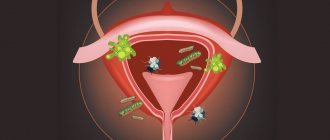Cystitis (inflammation of the bladder mucosa) is one of the most common pathologies of the genitourinary system, especially among women. Every woman, regardless of her age, has encountered one or another manifestation of cystitis at least once in her life.
Every year in Russia, up to 35 million cases of this disease are registered, and women experience symptoms of cystitis several times more often than men.
Due to the wide distribution of this disease, which often has a chronic relapsing course, information about the routes of transmission of infection during cystitis is relevant for the patient. The most popular questions at a doctor’s appointment: “Is cystitis sexually transmitted? Is cystitis contagious to a sexual partner?
The answer to this seemingly simple question is ambiguous, because everything depends on the type of cystitis, its main causative agent. Some types of cystitis can actually be transmitted through sexual contact.
Clinical picture of the disease
Clinical manifestations of inflammation of the bladder mucosa are quite specific. The most common symptoms of the disease are:
- 1Pain and burning in the lower abdomen, aggravated by urination;
- 2 Frequent false urge to empty the bladder;
- 3Urine excretion in frequent small portions;
- 4Externally, urine may look cloudy and contain various pathological impurities - mucus, flakes, and in severe cases blood;
- 5Sometimes body temperature may rise to subfebrile levels, although this is not typical for uncomplicated cystitis. The presence of an increase in temperature always indicates the severity of the disease and an unfavorable prognosis for the patient.
The main clinical symptoms of the pathology appear quickly (acute onset), reach their peak severity by the end of the first day of the disease and can persist for up to 6-7 days; Patients may lose their ability to work for 2-3 days.
The diagnosis can be confirmed by laboratory tests. Thus, with a routine examination of a general urine test, an increase in the level of leukocytes, proteinuria and bacteriuria can be detected.
Signs of cystitis
Inflammation of the bladder can be acute or chronic. The occurrence of pathology is accompanied by the following symptoms:
- Changes in urination, frequent urination;
- Pain when passing urine;
- The genitals hurt and itching;
- It feels like the bladder is not completely emptied;
- Bloody discharge in the urine;
- Pus and mucus in the urine;
- Pain in the lower abdomen.
With cystitis, the bladder is affected, so any changes in urination and pain are a reason to visit a doctor.
Types of uropathogens
When considering the problem of transmission of cystitis through sexual contact, it is important to distinguish two large groups of cystitis, which are based on two fundamentally different infectious processes:
- 1Nonspecific – caused by a variety of nonspecific pathogenic and opportunistic microflora;
- 2Specific – caused by sexually transmitted infections.
Separately, postcoital cystitis should be highlighted - this is a special type of cystitis, usually caused by nonspecific microflora and associated with congenital or acquired anatomical features of women (defects in the location of the external urethral opening, its hypermobility during sexual intercourse).
Summarizing the above, the answer to the question of sexual transmission of cystitis lies precisely in the original cause that caused it. Let's look at this in more detail.
Nonspecific cystitis
This type of inflammation of the cystic mucosa is caused by nonspecific pathogenic and conditionally pathogenic microflora (part of the normal microflora of human skin and mucous membranes).
The most typical pathogens of nonspecific cystitis are:
- 1 Escherichia coli (70-80%);
- 2Proteus (8%);
- 3Klebsiels (3.7%);
- 4 Staphylococci and streptococci (2-4%).
Mycoplasma (M. hominis) and ureaplasma (Ureaplasma urealyticum) are also of great importance. They are not classified as STD pathogens, however, these opportunistic microorganisms are a common cause of chronic recurrent cystitis.
The most common causative agent of urinary tract infections (hereinafter referred to as UTI), E. coli, is a normal representative of the intestinal microflora and is not an absolute pathogen.
Sometimes, due to anatomical reasons, if the rules of personal hygiene are neglected, it enters the lumen of the urethra, where it ascends directly into the bladder, provoking symptoms of inflammation.
The following can contribute to the penetration of E. coli into the bladder:
- 1Changes in the normal microflora of the vagina, reduction in the number of vaginal lactobacilli, vaginal dysbiosis, proliferation of yeast flora;
- 2Hormonal imbalance, taking hormonal medications, presence of diseases of the endocrine system;
- 3Frequent hypothermia, including local;
- 4 A diet rich in carbohydrates, saturated fats and poor in vegetables, fruits, and dietary fiber;
- 5Wearing tight underwear and clothing, which disrupts the blood supply to the pelvis;
- 6The presence of a permanent source of infection in the body, a tendency to stool disorders and intestinal dysbiosis;
- 7 Violation of the rules of healthy intimate hygiene, regular use of panty liners;
- 8Insufficiently frequent change of tampons and sanitary pads during menstruation;
- 9Sedentary work and a sedentary lifestyle (congestion in the pelvic organs);
- 10Use of non-traditional types of sexual contacts (oral, anal).
The most common route of penetration of pathogenic microorganisms into the lumen of the bladder is the ascending rise of infection from the urethra, however, the causative agent of cystitis can penetrate the mucosa through the lymphogenous and hematogenous route (with the flow of lymph and blood).
Nonspecific cystitis is one of the most common types of UTI and accounts for about 60-80% of all cases of the disease. With the right treatment, it stops quickly enough and does not cause significant harm to the body.
This type of cystitis is not contagious and is not transmitted to a partner through sexual contact. In other words, it is impossible for them to become infected through sexual contact.
Routes of infection
The disease itself cannot be transmitted from one partner to another during sex. The inflammatory process in the bladder is provoked by pathogenic bacteria that enter the excretory system during sexual intercourse and multiply there.
Infection without skin-to-skin contact, such as in a swimming pool or through a toilet, is unlikely. Typically, the main causative agents of cystitis are transmitted through household contact due to non-compliance with personal hygiene rules.
Transmission of cystitis from partner to partner
This pathology develops more often in women and, in particular, after intimate intimacy. This is explained by the anatomical structure of the urethra in the female body. It is shorter than that of men, much wider and has no physiological bends or narrowings. An infection introduced after intimacy easily enters the bladder through the ascending pathways, provoking inflammation of the mucous membrane.
Excessive aggressive microflora of a man attacks the genitourinary system of a woman. Against the background of reduced immunity, her body becomes vulnerable to all pathogens of cystitis.
It is relatively rare for the disease to occur in males after sexual contact. Naturally, inflammation acts as a secondary disease resulting from the spread of infection.
Risk factors
It is impossible to become infected with cystitis during sexual intercourse. Frequent reasons for its development in one of the partners after intimacy:
- disordered sex life;
- having multiple sexual partners;
- weakened immunity;
- changes in hormonal levels;
- untreated urological diseases;
- failure to comply with personal hygiene rules.
If the body is simultaneously affected by many negative factors, then the risk of illness after sex increases several times.
Infectious and bacterial cystitis
Despite the disease itself, its pathogens are sexually transmitted. These include: bacteria, fungi and viruses.
With cystitis, it is important to distinguish two fundamentally different infectious processes:
- Non-specific. Inflammation of the organ mucosa is caused by Escherichia coli, staphylococci and streptococci, gonococci, Proteus or E. coli. These bacteria live in small numbers on the mucous membranes and skin of all people. Once in the urinary tract, with a weakened immune system, they begin to actively multiply.
- Specific. The development of the disease is promoted by pathogens of sexually transmitted infections: gonorrhea, chlamydia, trichomonas and cytomegalovirus, genital herpes virus, mycoplasma and ureaplasma. They can be infected after vaginal, oral or combined sex in 80% of cases.
Pathogenic microorganisms are not part of the normal human microflora, so they become the main cause of the development of infectious and bacterial cystitis.
Postcoital inflammation
This is a recurrent bladder disease that occurs after intimate relationships. The first signs of the disease are observed within a day. In 80% of cases, postcoital cystitis develops due to rough or prolonged sexual intercourse. Lack of natural lubrication in women also leads to the appearance of microcracks in the vagina and urethra. In addition, the abnormal structure of the genitourinary organs in girls increases the risk of postcoital cystitis.
In such situations, pathogenic microflora quite quickly and easily penetrates the bladder through the urethra, causing inflammation. This form of the disease develops as a result of ascending infection. Relapses can occur with almost every sexual contact, even after undergoing comprehensive treatment.
The problem can only be solved if certain preventive measures are taken.
Why do women get UTIs more often?
According to statistics, the incidence of cystitis among women is approximately 6-8 times higher compared to men. This is mainly due to the peculiarities of female anatomy.
The female urethra is anatomically different from the male urethra. It is somewhat shorter and much wider, and also has no physiological bends or narrowings. The external opening of the urethra in women is located near the entrance to the vagina and anus, which facilitates the introduction of infection into the urethra, from where it ascends into the cavity of the bladder, causing inflammation of its mucous membrane.
As mentioned above, the incidence of cystitis among men is quite low and amounts to only 4-5 cases per 100 thousand population. Since the male urethra is narrow, convoluted, and has a greater extent compared to the female one, the occurrence of symptoms of cystitis in men under the influence of opportunistic flora (Escherichia coli) is rarely observed.
Conditionally pathogenic flora in men usually lingers in the lumen of the urethra, so clinical manifestations of urethritis are more often observed.
Therefore, the appearance of symptoms of inflammation of the bladder mucosa in men should alert the doctor and patient regarding its specific nature.
Nonspecific cystitis in men is more likely with decreased immunity, the presence of severe concomitant pathology, defects in the structure of the urethra, etc.
Root causes of the disease
The main role in inflammation of the bladder belongs to infectious microorganisms that enter the tissues of the genitourinary system in different ways. Often, infections in girls/women occur from the area around the anal ring and vaginal area during sex. This is explained by the fact that under normal conditions, microorganisms of opportunistic flora constantly live in these places and in the future can cause infection.
Men think little about whether cystitis is transmitted from woman to man. They suffer from it quite rarely due to the peculiar structure of the urinary organs: a long, narrow urethra, located far from the peri-anal zone. It is difficult for infections to enter the urethra and the development of inflammation is excluded. But, most often, a woman becomes infected with cystitis from a man.
This happens during intimacy, when sexual partners change their aggressive microflora (pathogens that trigger the inflammatory process, if the necessary conditions are present). Initially, the infection actively develops in the vaginal walls, on the cervix, then reaches the bladder. Whether the infection reaches its final result or not depends on the following circumstances:
- failure to maintain personal hygiene, improper washing of intimate organs (from the anus towards the vagina);
- unprotected sex;
- constant change of sexual partners;
- the use of various objects during sex that injure the organs of the urinary system, which accelerate infection;
- weak immune defense.
Cystitis is sexually transmitted if the cause is Candida fungus. Infection and initiation of this process is possible in immunologically weak people. In this case, the candida fungus is transmitted and leads to the development of thrush in the reproductive system (white granular discharge, itching), which is complicated by inflammation of the urethra and bladder.
The concept of a specific infection
Cystitis, which is caused by pathogenic microorganisms classified as sexually transmitted infections (STDs), is called specific.
If cystitis is specific, then transmission through sexual contact occurs in more than 80% of cases.
The main sexually transmitted infections that can lead to inflammation of the bladder mucosa are:
- Chlamydia is caused by Chlamydia trachomatis. One of the most common STDs. It is often asymptomatic and has no specific clinical signs, especially in women. You may experience unpleasant discharge from the vagina, urethra, and genital itching. In genetically predisposed individuals, symptoms of the disease, in addition to urethritis or cystitis, may include uveitis and asymmetric arthritis (Reiter's triad).
- Gonorrhea is caused by the gram-negative diplococcus Neisseria gonorrhoeae. Specific signs to suspect gonorrhea are thick purulent discharge from the urethra, vagina, genital itching, pain and burning during sexual intercourse;
- Trichomoniasis is caused by Trichomonas vaginalis. The distinctive symptoms are the appearance in women of profuse watery or foamy vaginal discharge that is yellowish in color. Men may notice discharge from the urethra. Patients are concerned about genital itching, as well as a tendency to form ulcers on the mucous membranes of the genital organs;
- Mycoplasmosis is caused by Mycoplasma genitalium.
How to distinguish cystitis caused by sexually transmitted infection?
It is important to remember: The nature of the inflammatory process can only be determined at an appointment with a doctor, but there are a number of signs that can alert you to a sexually transmitted infection.
The main differences between cystitis caused by STIs:
- 1Specific cystitis in women is ALWAYS accompanied by vaginitis, vaginal discharge, and sometimes genital itching and dyspareunia.
- 2 In men with a prolonged course of sexually transmitted infections, the development of prostatitis and infertility is possible.
- 3Specific cystitis begins, as a rule, with the phenomena of urethritis.
- 4 Upon examination, redness and pathological discharge from the urethra can be detected.
- 5Cystitis due to STDs is resistant to standard therapy and has a protracted progressive nature.
- 6Often develops after a change of sexual partner or after unprotected sexual contact.
- 7 It should be noted that cystitis in men always requires examination for sexually transmitted infections.
Diagnosis of cystitis
Diagnosis of the disease begins with a mandatory consultation with a urologist and a general urine test. Sometimes this is enough to start treatment. However, there are other situations. For example, if the picture of the disease is atypical, the doctor may suggest performing an ultrasound.
It is worth noting that acute cystitis can spread to the upper urinary tract and lead to pyelonephritis, that is, inflammation of the kidneys. With this disease, the tactics of examination and treatment change radically.
With recurrent cystitis, the range of necessary examinations expands. To understand the cause of chronic cystitis, your doctor may recommend the following tests:
- bacterial culture of urine (that is, identification of bacteria in urine, their number and type);
- screening for sexually transmitted infections;
- examination for viral infection.
Postcoital cystitis
It is also worth mentioning postcoital cystitis, which occurs in women immediately after sexual intercourse.
It is usually caused by nonspecific microflora, but has a clear chronological connection with intimacy, so many women believe that it is sexually transmitted. This is a common misconception.
The penetration of nonspecific microflora into the bladder cavity during sexual intercourse, in addition to the anatomical features of the female urethra, can be facilitated by such a congenital developmental anomaly as hypermobility of the external urethral opening and its transfer directly to the border with the vaginal epithelium.
With this anomaly, during sexual intercourse, flora from the vagina is thrown into the urethra, which can subsequently lead to urethritis or cystitis.
This type of cystitis usually debuts with the onset of sexual activity, has a chronic, sluggish nature and is difficult to treat.
Postcoital cystitis occurs exclusively in women. The main difference that allows us to differentiate this type of cystitis from a specific one is the absence of symptoms of inflammation of the genital organs.
Measures to prevent postcoital cystitis:
- 1Wearing underwear made from environmentally friendly and breathable materials.
- 2Following the rules of healthy intimate hygiene, daily washing with warm water without using aggressive detergents, as well as washing before and after sexual intercourse.
- 3Forced urination after sexual intercourse.
- 4 Refusal to use spermicides that disrupt the vaginal microflora.
- 5Use of additional lubricant during sexual intercourse.
- 6 Refusal of douching.
- 7Prevention of hypothermia.
- 8Compliance with drinking regime.
Prevention of postcoital cystitis is possible and necessary for all women prone to this problem. If there is no effect from preventive measures, you should definitely consult a doctor for individual selection of therapy, and possibly for surgical correction.
Does cystitis pass from woman to man sexually?
The bladder in men becomes inflamed relatively rarely. But it is noteworthy that cystitis can be transmitted to a man from a woman during sexual intercourse and vice versa. If you have a hectic sex life or change your partner, cystitis can be “infected” through sexual contact.
Signs of the disease may also appear if hygiene rules are not followed. If a man’s immunity is strong, then it is unlikely that the bacteria he received from his partner will cause inflammation, but weakened immunity can cause pathology.








